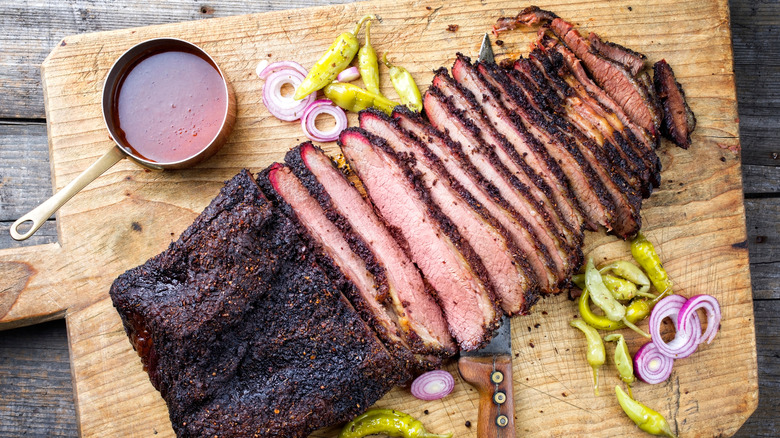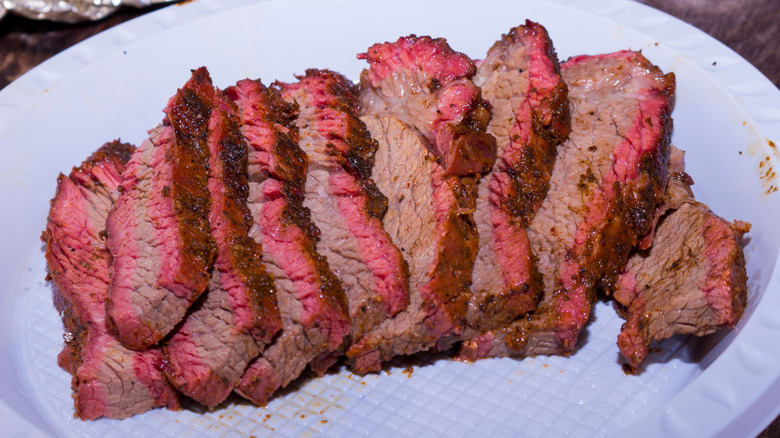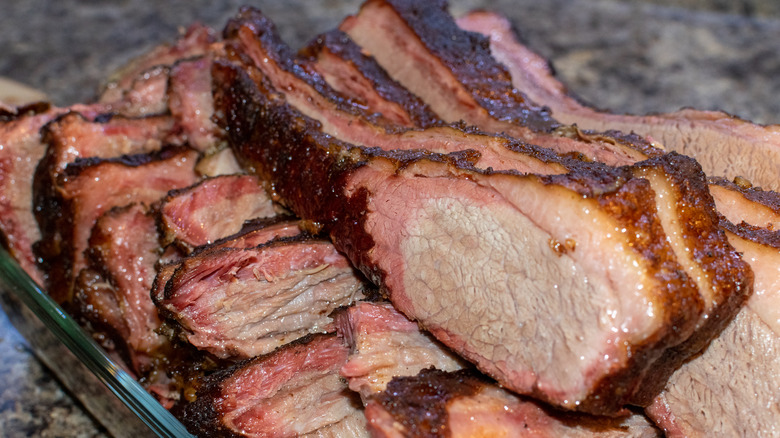Why Smoked Meat Might Still Be Pink Inside
In the world of backyard barbecuing, pitmasters have been whispering about "smoke rings" with reverence for a long time. Supposedly if you grab a knife and slice through perfectly smoked meat, immediately below the browned crust is a ring of pink that winds its way around the outer circumference of the meat. Anyone who's achieved this ring is heaped with praise for their skill with the smoker.
But what is this pinkish ring, exactly? At first glance, this rosy band might raise some eyebrows (and concerns) for those who don't know what they are. They look almost as if the meat is still undercooked just around the edges. (And while they're usually not an indication of the meat being undercooked, it's important to always use a meat thermometer to be sure.)
The good news is that, yes, the meat is most likely fully cooked — but you'll want to check with a thermometer — and the smoke rings can be explained with a bit of science. But there's also bad news: If you've been believing that smoke rings are the only hallmark of flavorful and tender smoked meat, the truth can be somewhat disappointing.
The science of smoke rings
The secret behind that pink ring in your smoked meat lies in a protein called myoglobin. This molecule is a close cousin to hemoglobin, which you might remember from high school biology class as the protein that carries oxygen in our blood. Both myoglobin and hemoglobin contain a pigment called heme, which gives the meat its distinctive blood-red color.
Here's where things get interesting: Raw meat actually starts off purplish, but it turns bright red when exposed to air. Leave it out for a little bit longer, and it'll eventually turn a rusty shade of brown that you'll find in very well-done steaks. This color-shifting phenomenon can be explained by looking at myoglobin's relationship with oxygen. Specifically, this protein is very reactive to oxygen — just a touch, and it'll turn a new color.
When you put the meat into a smoker and light up the wood chips, what binds to the myoglobin (instead of oxygen) is nitrogen dioxide or NO2. A lot of this gas is released when you burn wood chips like hickory in a smoker. NO2 essentially prevents myoglobin from reacting with oxygen, which "freezes" the color of the meat. And it being a gas, NO2 can't penetrate deep into the meat slab, so what you get is a ring around the exterior of the meat that stays a rosy hue while the rest has turned into a caramel brown.
Do smoked ringed meat taste better?
Smoke rings have an almost mythical status among many pitmasters, who believe that meats with this ring on them taste far better than those that don't. The truth can be both disappointing and encouraging. No, this reddish ring has no effect on the final flavor of the meat. The nitrogen dioxide that causes it is tasteless, so its presence really doesn't change the flavor or the texture of the meat at all save for the color. The smoke ring is only useful for two things: Showing how much NO2 managed to bond with the meat's exterior before it was fully browned, and proving the meat was genuinely cooked in a smoker rather than any other type of grill.
Of course, it's also a reminder that we can't rely on vision alone to decide whether meat is fully cooked. You should always use a meat thermometer to check whether smoked meat is ready to serve, because color isn't necessarily going to be an indicator.
If you've been struggling to get a smoke ring at home, don't sweat it. What will truly impress your guests is nailing the cooking time and serving those smoked beef plate ribs up with a good marinade (but admittedly, if you do manage to get a smoke ring, it'll surely be a nice conversation starter).


